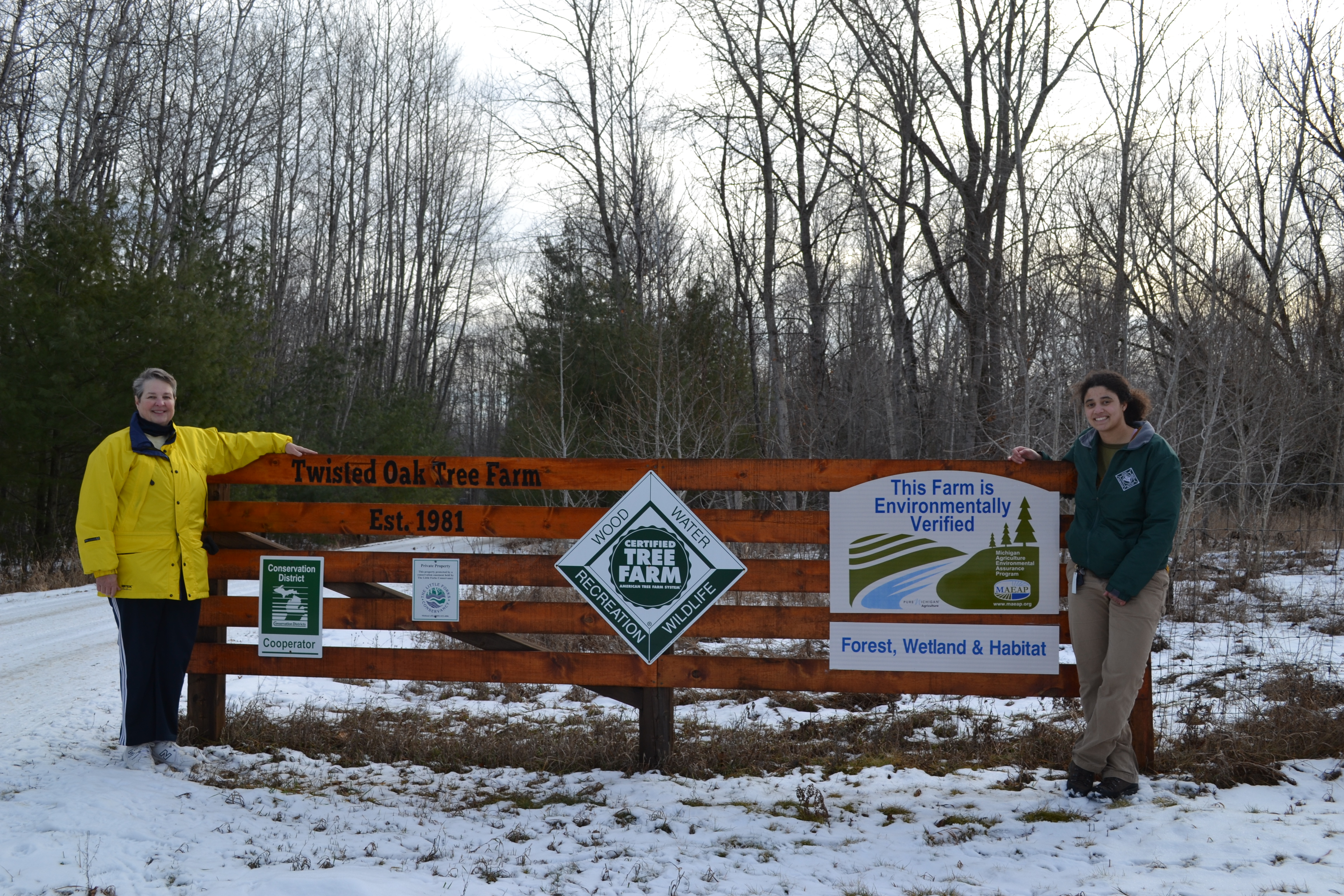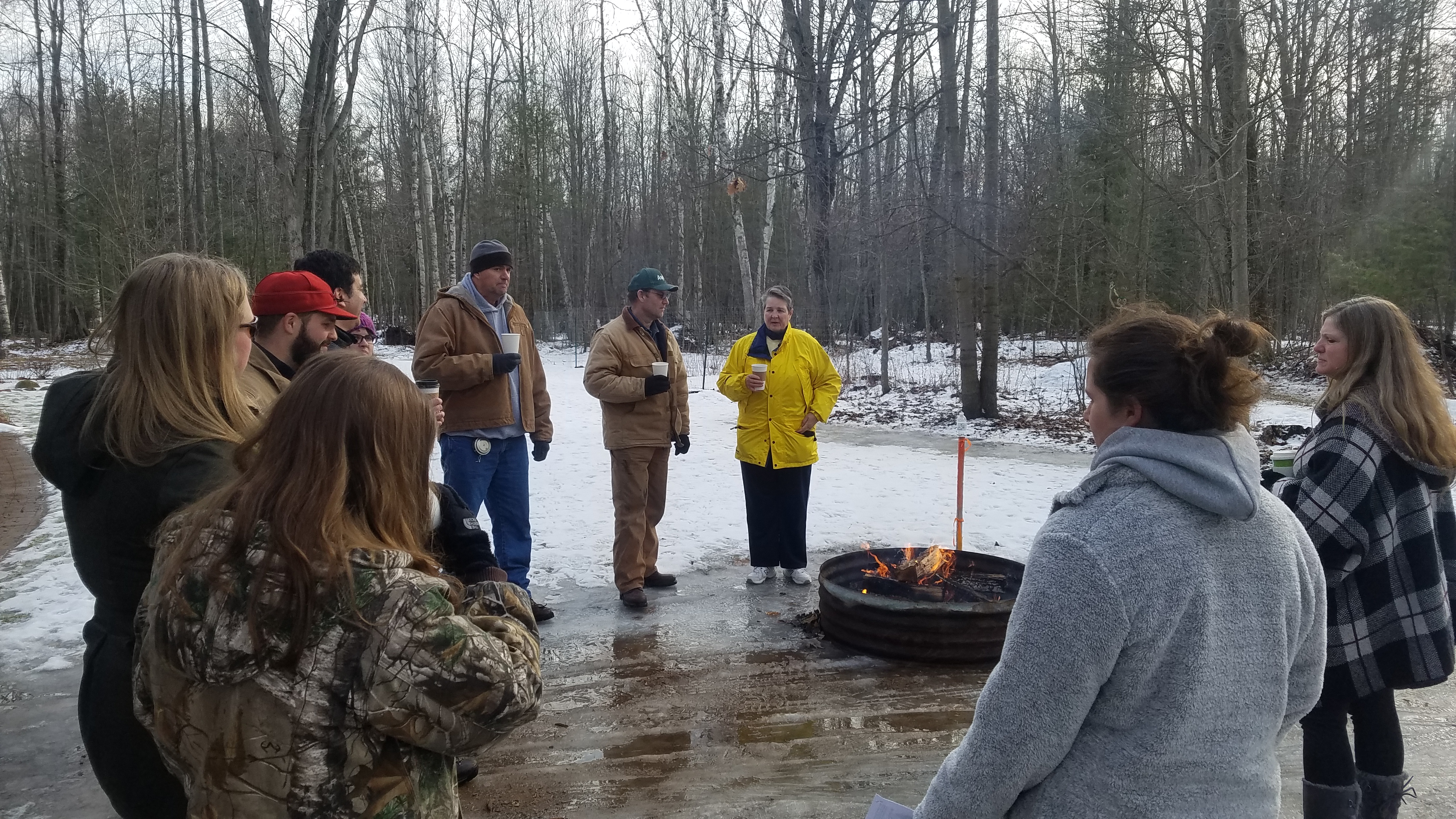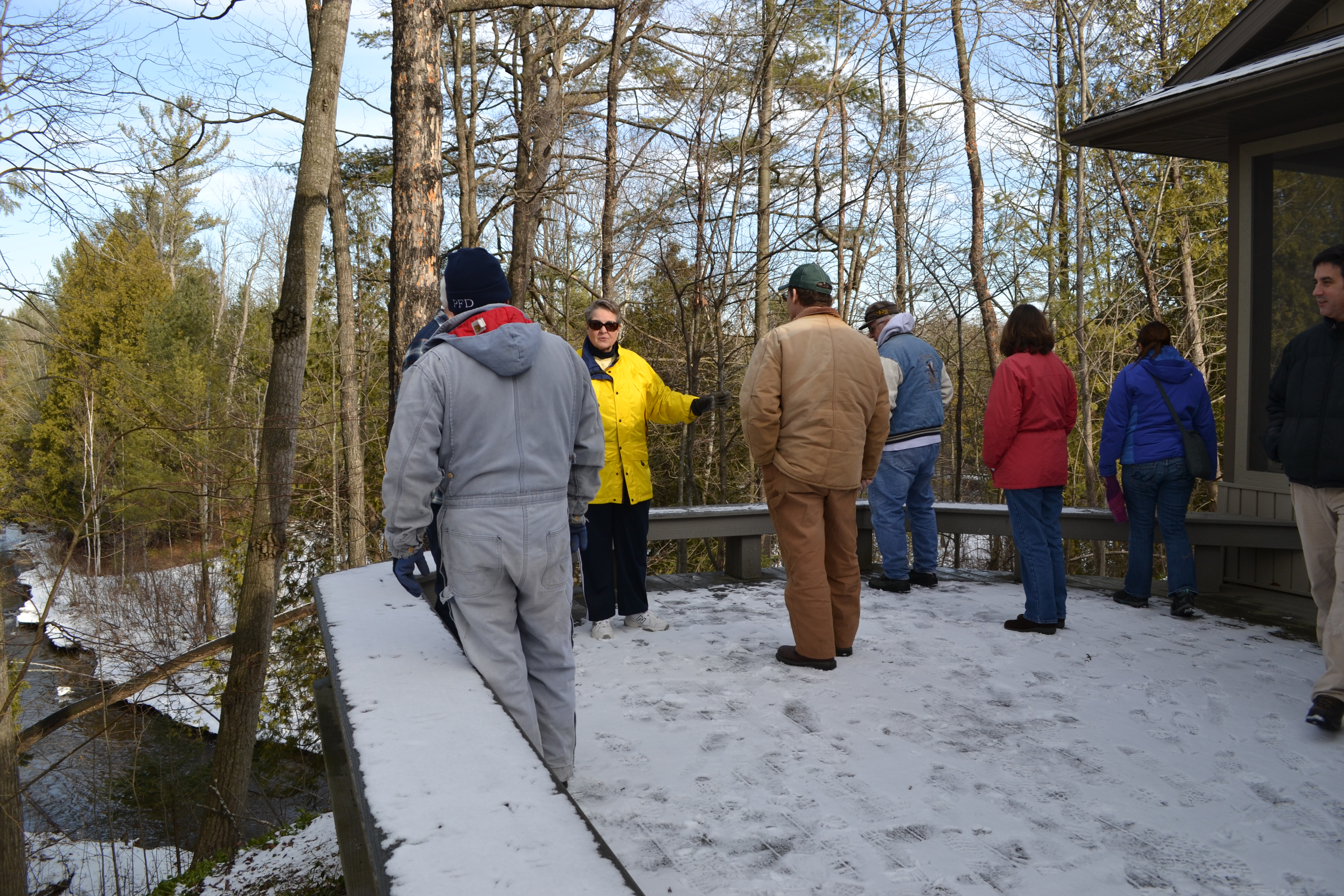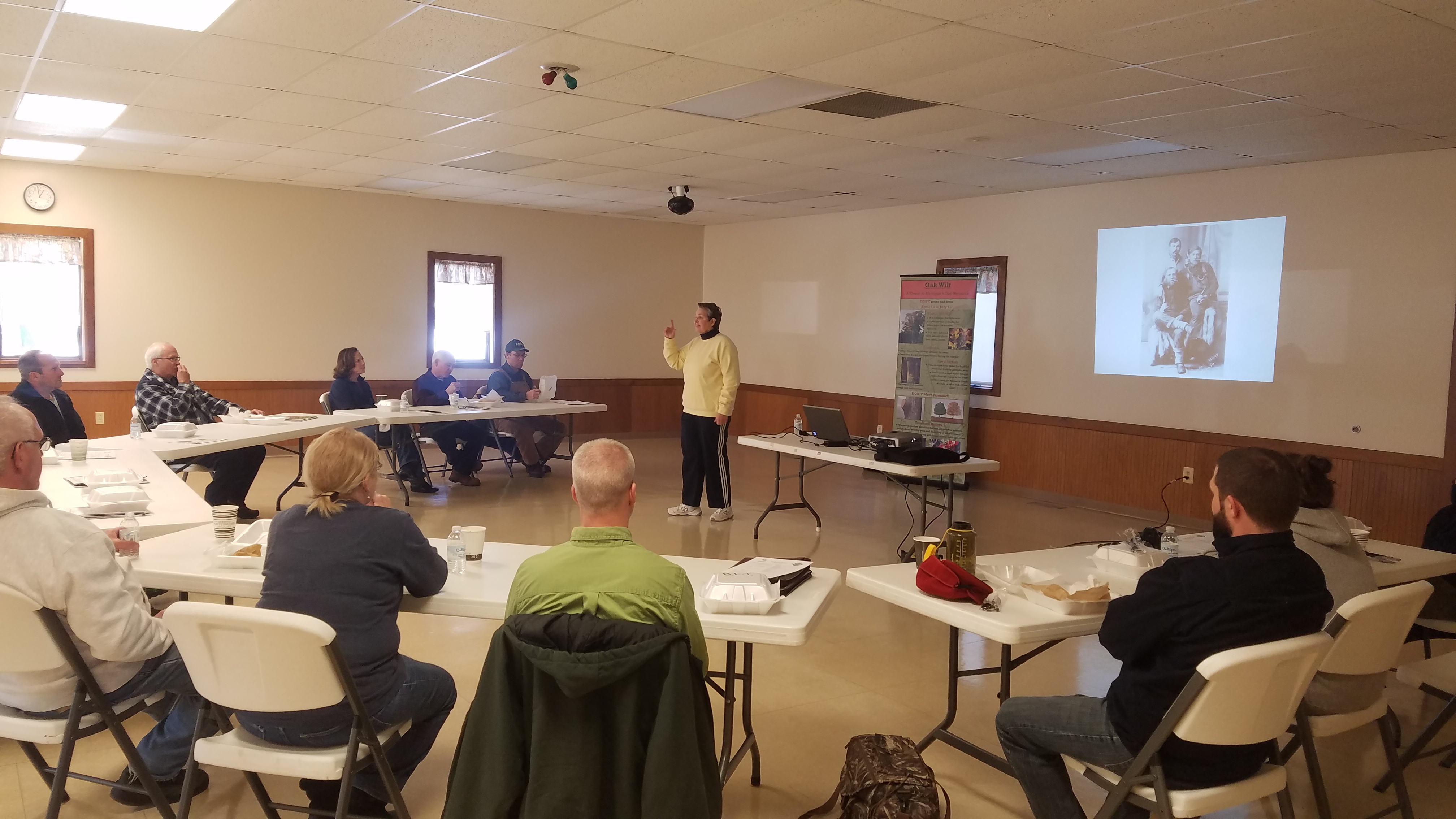North Central Nominee: Sally Hightower from Michigan
What makes them outstanding?
Sally truly cares about
conservation as she is actively involved in several conservation organizations
and activities in Michigan, such as the local Conservation District. Most
people have no desire to own property that was used as a farm dump site, but
Sally recently purchased a neighboring parcel like this. She plans to restore
and cleanup the site. Improved aesthetics is one reason for this, but
groundwater contamination is another big concern. The West Branch Tittabawassee
River flows through the property, so her actions directly affect quality and
fish habitat are very important. She has done a lot of work to keep her section
of the river healthy. When a part of the bank started to have some erosion
issues, she took it upon herself to solve the problem. With the help of her
wife Linda, they brought stones down to the river front to mitigate erosion and
reinforce the stream bank. More recently they brought in a boulder to add more
structure to the stream habitat. Sally has been working closely with Trout
Unlimited as well to complete these actions. In 2017 they put temperature data
loggers in her section of stream as a part of their research in the area about
stream temperatures. After six months, the temperatures were satisfactory for
healthy trout. Sally embraces and embodies the connection between woods, water
quality, wildlife, and habitat.
no desire to own property that was used as a farm dump site, but
Sally recently purchased a neighboring parcel like this. She plans to restore
and cleanup the site. Improved aesthetics is one reason for this, but
groundwater contamination is another big concern. The West Branch Tittabawassee
River flows through the property, so her actions directly affect quality and
fish habitat are very important. She has done a lot of work to keep her section
of the river healthy. When a part of the bank started to have some erosion
issues, she took it upon herself to solve the problem. With the help of her
wife Linda, they brought stones down to the river front to mitigate erosion and
reinforce the stream bank. More recently they brought in a boulder to add more
structure to the stream habitat. Sally has been working closely with Trout
Unlimited as well to complete these actions. In 2017 they put temperature data
loggers in her section of stream as a part of their research in the area about
stream temperatures. After six months, the temperatures were satisfactory for
healthy trout. Sally embraces and embodies the connection between woods, water
quality, wildlife, and habitat.
Tree Farmer story
Twisted Oak Tree Farm, owned by Sally Hightower, a retired school counselor, first purchased her land in the 1981 from a local connection on the school board for pennies on the dollar. It is rumored that the previous owner needed some cash to stave off their mafia connections in Chicago, and Sally just so happened to be looking to buy at the right time.
She and her wife, Linda, have built a home and life on the property and have faced problems with eroding streambanks on the West Branch of the Tittabawassee River, a major river that flows directly into the Saginaw Bay of Lake Huron, and environmental restoration of hazardous farm material waste. Sally reached out to the local Trout Unlimited chapter to learn how to help the trout stream, and brought stones down to the river front to mitigate erosion and reinforce the stream bank. Cleanup of the abandoned farm waste is beginning and will be a long, arduous process to complete safely. It is unknown what soil samples will reveal and further challenges they will face to restore this ground into its pre-farmed condition.
Sally first joined Tree Farm in 1985 to get "the green sign" out by the road next to her driveway. While completing a harvest, her forester recommended the Tree Farm program. She learned that that sign meant she would be recognized for her accomplishments thus far and into the future, as well as getting regular inspections from forestry professionals. She has had a few different inspectors over the years, always reaching out for new information she could glean from different consultants and state and local agencies.
 Forest management, including
harvests, are not new to Sally and Linda. Their first harvest was completed in
1985 and was a timber stand improvement to salvage low quality pine, aspen, and
birch. The wood recovered from the improvement was purchased by Dow Corning,
one of the largest chemical manufacturers in the world, to use as biomass in
their plants in Midland, Michigan. Their next harvest was completed in 2011.
The 25 acre aspen regeneration harvest created valuable and much needed early
successional wildlife habitat for deer, turkey, ruffed grouse, woodcock, and
other game. Turkeys enjoy the new habitat especially, as they are found
constantly on the property and and becoming a rather whimsical nuisance. When
small scale projects arise, Sally is the first to grab her chainsaw and do it
herself. She has faced subtle gender discrimination when purchasing and
servicing her equipment, being asked if it is for her husband. With a smile,
Sally takes her freshly sharpened saw home to fell a tree.
Forest management, including
harvests, are not new to Sally and Linda. Their first harvest was completed in
1985 and was a timber stand improvement to salvage low quality pine, aspen, and
birch. The wood recovered from the improvement was purchased by Dow Corning,
one of the largest chemical manufacturers in the world, to use as biomass in
their plants in Midland, Michigan. Their next harvest was completed in 2011.
The 25 acre aspen regeneration harvest created valuable and much needed early
successional wildlife habitat for deer, turkey, ruffed grouse, woodcock, and
other game. Turkeys enjoy the new habitat especially, as they are found
constantly on the property and and becoming a rather whimsical nuisance. When
small scale projects arise, Sally is the first to grab her chainsaw and do it
herself. She has faced subtle gender discrimination when purchasing and
servicing her equipment, being asked if it is for her husband. With a smile,
Sally takes her freshly sharpened saw home to fell a tree.
Her involvement in other conservation programs, such as the Michigan Agriculture Environmental Assurance Program (MAEAP) Forest Wetlands Habitat*A*Syst, allows her to promote Tree Farming to many other conservation minded people. The property is also held in a conservation easement with the Little Forks Conservancy. As a lifelong educator, she has also promoted stewardship in general. She is the president of the Gladwin School Board and Gladwin Conservation District. For her service to conservation efforts, Sally serves on the Advisory Board for the Clare Forestry Assistance Program and the board of directors for the Little Forks Conservancy. Through these networks, she promotes Tree Farm and responsible forestry to a wide audience. Sally is always encouraging her neighbors to practice good stewardship. Deer hunting is very popular in her neck of the woods and she shows the other residents how timber harvesting can actually improve deer habitat, using her harvests as an example. Even though many of these neighbors have enjoyed the woods their entire lives, they still have many misconceptions about the relationships between harvesting timber and deer populations. Sally is sure to let them know that enrolling in Tree Farm is a great way to ensure good stewardship and to help promote good wildlife habitat with access to the professional inspectors in Michigan.
Sally has also begun to host Tree Farm field days on her property. The first of these focused on winter conservation topics, such as winter tree ID, wildlife habitat, logging history, and a tour of her most recent harvest. Foresters from the Clare-Gladwin Conservation District, Ogemaw-Oscoda Conservation District, and Otsego-Crawford-Roscommon Conservation District helped put on the event, as well as an extension Educator from Michigan State University Extension, all female foresters. This was attended by 25 people, both local citizens and folks from as far away as Jackson, in southern Michigan, almost 150 miles away. David and Joy, of Jackson, said they were impressed and the field day was worth traveling for. She has plans to do more in the future and was very proud of her first field day. She said the group "hit this one out of the park."
Sally takes her Tree Farming very seriously and is very active. She practices good stewardship that goes above and beyond Tree Farm and is always willing to do more. Tree Farm represents being a leader in the community for forest stewardship and Sally is just that.
For the following areas describe how the landowner's management addresses it
Wood: Sally has had multiple
harvests on her property, the first in 1985 as a timber stand improvement and
the second in 2011 for aspen regeneration, both with qualified foresters and
logging professionals. She cuts some of her own trees down for firewood and
timber stand improvement as well.
improvement and
the second in 2011 for aspen regeneration, both with qualified foresters and
logging professionals. She cuts some of her own trees down for firewood and
timber stand improvement as well.
The first harvest was completed shortly after she purchased the property, sometime between 1981-1985. She had pine and aspen harvested to power Dow Corning's wood pellet energy operation. After this harvest, Sally with the help of a group of college students planted 1200 red pine for future wood resources.
Aspen regeneration harvest was conducted in 2011. Since this aspen clone was on the older side, the regeneration was slower than anticipated. However, regeneration has been valuable for wildlife habitat.
Water: Sally actively is involved in water quality management and recognizes the variety of benefits a quality stream can have for all. She not only cares about her own section of the river running through her property, but is cognizant of how her actions affects those downstream. Sally has stabilized streambanks of the West Branch of the Tittabawassee River and enhanced trout habitat with cooperation of Trout Unlimited. Sally purchased the neighboring old farm dump from Butman Township. This property was only a few acres, but she plans to restore and restabilize the site. This dump can potentially be leaking pollutants into the nearby river and her efforts will improve water quality and fish habitat for all downstream. The Tittabawassee River is a major tributary into the Saginaw Bay watershed, a key area for Great Lakes quality.
Wildlife including threatened and endangered species: Sally's aspen regeneration harvest added new early successional wildlife habitat for deer, turkey, ruffed grouse, woodcock, rabbit, hare, and others.
A few years ago, Sally planted a few dozen oak trees to improve mast component in her forest for deer.
She allows deer hunting on
her property and has asked that hunters take a doe before taking a buck. This helps to balance the local deer
population. This area of Michigan has an overabundance  of deer and it has been
hindering forest regeneration.
of deer and it has been
hindering forest regeneration.
Sally's wildlife management has been working very well, as it's nearly impossible to go to her property and to not see any wildlife.
Recreation and Aesthetics including special sites: Sally has allowed her friend and neighbors to use her property for deer hunting. She asks those hunting on her property to take a doe before taking a buck to help balance the deer population. Approximately 2-5 hunters use the property to harvest venison.
The property has well-maintained trails that provide great access to the whole property. Sally is more than happy to take visitors on ATV rides to see her property. Sally and Linda also walk their trails with their dog, Abby.
There are several special sites on the property. One of which are the twisted oaks that give the tree farm it's name. They are two massive oak trees that twist around each other as they grow up. Another are two legacy trees, a red pine and white pine, that are both over 100 years old. Throughout the property, there are also many white pine stumps that came from the great White Pine Logging Era, from the 1870-1910.


